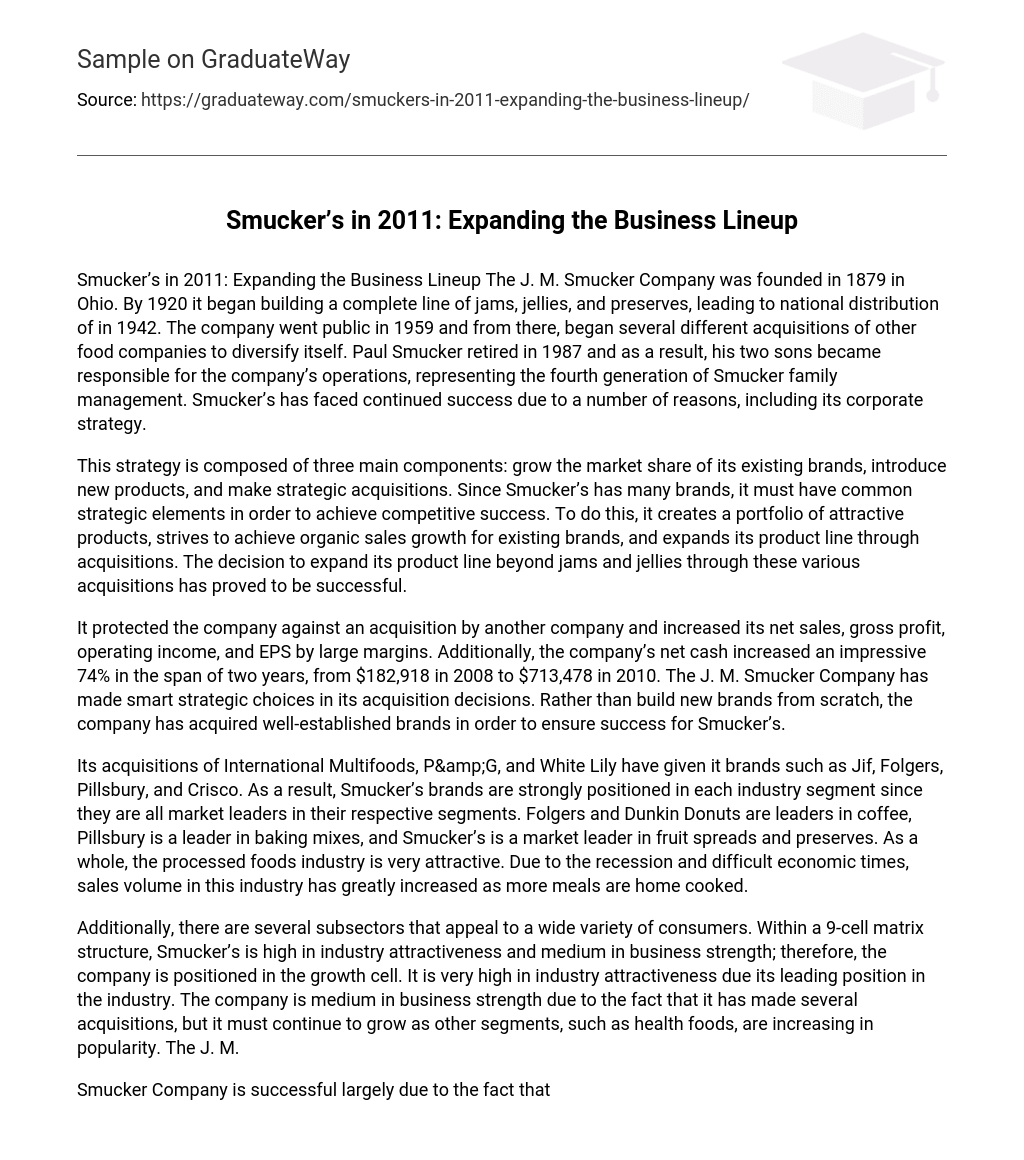Smucker’s in 2011: Expanding the Business Lineup The J. M. Smucker Company was founded in 1879 in Ohio. By 1920 it began building a complete line of jams, jellies, and preserves, leading to national distribution of in 1942. The company went public in 1959 and from there, began several different acquisitions of other food companies to diversify itself. Paul Smucker retired in 1987 and as a result, his two sons became responsible for the company’s operations, representing the fourth generation of Smucker family management. Smucker’s has faced continued success due to a number of reasons, including its corporate strategy.
This strategy is composed of three main components: grow the market share of its existing brands, introduce new products, and make strategic acquisitions. Since Smucker’s has many brands, it must have common strategic elements in order to achieve competitive success. To do this, it creates a portfolio of attractive products, strives to achieve organic sales growth for existing brands, and expands its product line through acquisitions. The decision to expand its product line beyond jams and jellies through these various acquisitions has proved to be successful.
It protected the company against an acquisition by another company and increased its net sales, gross profit, operating income, and EPS by large margins. Additionally, the company’s net cash increased an impressive 74% in the span of two years, from $182,918 in 2008 to $713,478 in 2010. The J. M. Smucker Company has made smart strategic choices in its acquisition decisions. Rather than build new brands from scratch, the company has acquired well-established brands in order to ensure success for Smucker’s.
Its acquisitions of International Multifoods, P&G, and White Lily have given it brands such as Jif, Folgers, Pillsbury, and Crisco. As a result, Smucker’s brands are strongly positioned in each industry segment since they are all market leaders in their respective segments. Folgers and Dunkin Donuts are leaders in coffee, Pillsbury is a leader in baking mixes, and Smucker’s is a market leader in fruit spreads and preserves. As a whole, the processed foods industry is very attractive. Due to the recession and difficult economic times, sales volume in this industry has greatly increased as more meals are home cooked.
Additionally, there are several subsectors that appeal to a wide variety of consumers. Within a 9-cell matrix structure, Smucker’s is high in industry attractiveness and medium in business strength; therefore, the company is positioned in the growth cell. It is very high in industry attractiveness due its leading position in the industry. The company is medium in business strength due to the fact that it has made several acquisitions, but it must continue to grow as other segments, such as health foods, are increasing in popularity. The J. M.
Smucker Company is successful largely due to the fact that its businesses and brands are a great strategic fit. Smucker’s has acquired brands and their products that go hand-in-hand with each other, such as peanut butter and jams, cooking oil and baking mixes, and coffee and syrups. There are also value-chain opportunities for Smucker’s, including the delivery of a mix of products to the final customer. For instance, the company can combine the above matched products in its advertising, as well as deliver these matched products together. This ultimately results in cost savings and a better value for the company.
Additionally, Smucker’s has different cost sharing opportunities it can employ among its different brands. These include combined packaging and shipping, the consolidation of operations to fewer locations, and combined product storage among its various brands. The current lineup of businesses and brands exhibits a good financial resource fit for Smucker’s. The company’s net sales and profits have increased across the board. Additionally, it is evident from the financial statements that all of Smucker’s segments are generating a profit that is also facing continued growth.
The company’s businesses are cash cows as all of the segments generate cash flow that is above the company’s internal requirements. The cash flow characteristics of the J. M. Smucker Company disclose that the company generates enough cash to invest in further acquisitions and current operations. Although there was a 37% decrease in cash and cash equivalents from financing activities from year 2009 to year 2010, the company used these funds to invest in additional strategic acquisitions.
As a result, Smucker’s experienced a 37% increase in net cash provided by operating activities. These cash flow statistics disclose that Smucker’s has the available cash to invest in both further acquisitions and its current business operations. In order for Smucker’s to improve its financial performance even further, it should use its available cash to invest in new opportunities, close underperforming facilities, and combine production lines to save on operating costs. The company should also allocate its marketing resources in order to allow for organic growth.
Marketing is an important expense that contributes to this growth since it helps increase output and enhance sales. In 2010, Smucker’s increased advertising by 70% and added 15 new commercials, along with digital and social media advertising. Although Smucker’s is in a very strong position, it must increase its brand presence and recognition in large retail grocery stores to strategize against further consolidation within this industry. The company should continue its restructuring strategy, which is to divest certain businesses or brands that are a low strategic priority.
In addition, due to the fact that the company has the available cash on hand, it should continue to invest in additional acquisitions since it has benefitted from its past investments. Specifically, Smucker’s would benefit from an acquisition with a health foods company. This would expand its health foods segment, which is an increasing customer concern. The J. M. Smucker Company is a business in a strong industry and financial position, and with minor adjustments and strategic actions, it will continue to grow and see market success.





